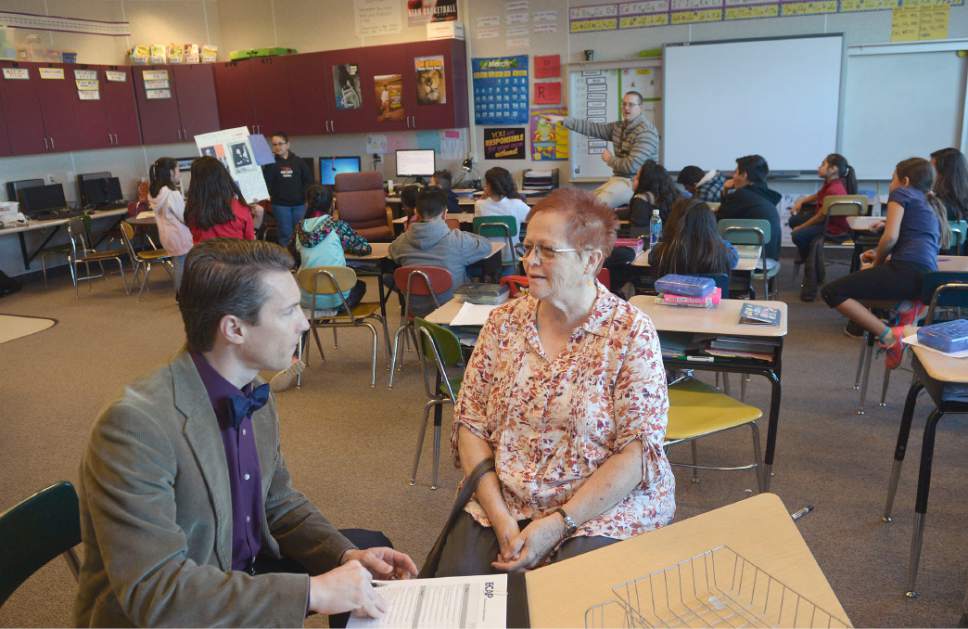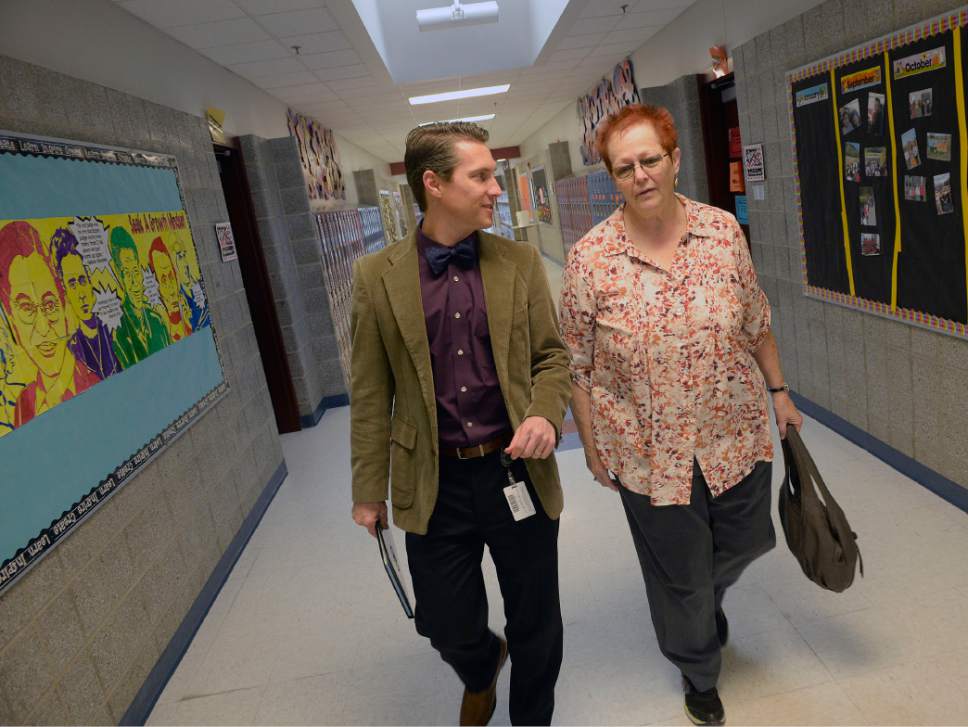This is an archived article that was published on sltrib.com in 2017, and information in the article may be outdated. It is provided only for personal research purposes and may not be reprinted.
Backman Elementary teacher Daniel Mills doesn't mince words about his lack of teaching experience, limited to a year as an assistant educator and two years overseeing gym classes.
"I want to teach," Mills said, "but I have zero knowledge about theory and skills."
Since last fall, he has been in charge of his own fourth-grade classroom through the state's Alternative Routes to Licensure program, which allows teachers to complete on-the-job certification in lieu of a university education program.
He also has the help of 40-year classroom veteran Pat Draper, who mentors Mills as part of the Salt Lake City School District's Peer Assistance Review, or PAR, program.
"It's for me. I love education," Mills said of his career choice. "I'm never going to be rich, but I get to wake up every day and I don't dread going to work."
The school district has benefited from $400,000 in state funding each year to keep PAR running. That funding was cut by state lawmakers last week, putting the mentoring program's future in question — just as some districts are struggling to retain teachers.
A new report by the University of Utah's Education Policy Center found that among the teachers who entered the public education system in 2007, 56 percent were gone by 2014. Younger teachers — age 25 or less — were the most likely to leave the profession, with one out of every five quitting education by their second year.
Mills has a statistical advantage through the PAR program, which launched in 2011. Among the program's first batch of educator, currently in their fifth year, 77 percent are still teaching.
"We don't retain everybody," PAR supervisor Logan Hall said, "because we also help identify teachers who aren't suited for this profession."
Salt Lake school board president Heather Bennett said PAR will likely continue in some form, though not without some painful choices. The school district spends $200,000 of its own money to support PAR and Bennett said school board members are grasping to cover the state's $400,000 share by pulling cash from other key district needs.
"It's our top priority," Bennett said. "We had hoped to be able to expand it, and we probably can't do that."
—
Getting extra help • Mentoring of novice teachers by veteran educators is relatively common in public schools. But in most cases, mentors have their own classroom duties, limiting the time they can spend helping colleagues.
That less formal in-school mentoring happens in Salt Lake City School District, but PAR provides added support to first-year employees through so-called "consulting teachers" who only work with other educators. The bulk of PAR funding, Hall said, goes to hire additional classroom faculty to fill staffing holes left open by these consultants.
"It allows us to have [mentoring] as their full-time focus," Hall said, "and really spend their time having the flexibility needed to help the teachers."
One of the district's two original consulting teachers, Draper said she is assigned to mentor 14 teachers. She visits each weekly for an hour to 90 minutes, she said, observing classroom instruction, providing feedback and helping set goals.
"The magic is working with teachers who are open and want to do the best that they can," she said.
Draper's feedback helps Mills improve on classroom management and discipline, while making his lessons more engaging and interactive than "drill and kill" lectures from the white board every day.
Mills praised his in-school mentor, "but she can't come in once a week and watch," he said. "The nature of the beast is you can't get as much feedback [without PAR]."
Peer Assistance Review doesn't address all of the challenges that push teachers out of the profession, Hall said. Pay is still relatively low, the demands are high and Utah's class sizes are among the largest in the nation.
But a full-time consultant can provide the equivalent of five year's worth of training in a single year, Hall said, which helps lighten the load for both teachers and school principals.
"It helps them feel more successful at what they're doing," Hall said. "I think that goes a long way."
—
Victim of success • Many involved with PAR said they were disappointed to see state funds cut for one of the few initiatives with a record of keeping teachers in the classroom.
"I was expecting that our legislators would be supportive of anything that showed promise in retaining teachers and supporting them," said Susan McFarland, president of the Salt Lake Education Association.
A state lawmaker influential in school funding issues countered that while the Legislature plays a role in launching new school programs, decisions to maintain or expand them are best left to district administrators.
Rather than continue PAR indefinitely, or make it a mandate throughout the state, said Rep. Dan McCay, R-Riverton, it is better to keep school funding unrestricted and give local administrators discretion on where they spend it.
"No two districts are the same," said McCay, who chairs the Legislature's Public Education Appropriations Subcommittee. "They all have different tools available to them through [per-student funding] to solve the teacher shortage." While PAR funding was cut, lawmakers approved a new pilot program that would award $5,000 bonuses to effective teachers who remain at or move to high-poverty schools. The budget also included new funding to cover the cost of teacher's licenses.
"I recognize that everybody would like one program to stick around or another," McCay said. "I just expect that at some point, as these pilot programs roll in, they will also roll out."
But Rep. Joel Briscoe, D-Salt Lake City, countered that lawmakers spend millions of dollars each year on learning software programs with marginal results, but cut cash for a program mitigating one of the most serious challenges facing public education.
"It's frustrating to see a successful program denied funding because it is successful," Briscoe said. "I can come to no other conclusion but that the Legislature loves technology more than it loves teachers."
He said the argument that pilot programs need to be phased out would be more acceptable if it was applied consistently to the education budget.
"It looked to me like we were picking and choosing because it was the only program, the only one, they stopped funding," Briscoe said. "If you were a cynic, you might wonder."
McCay's co-chair, Sen. Lyle Hillyard, R-Logan, said the appropriations committee is planning a year-long review of Utah's education budget. He said PAR, despite its successes, was ripe for revision since it was being used by a single school district.
"It sounded like a good program," Hillyard said. "I hope to hear a presentation this summer or next session about what we have learned and if it is worthwhile to do statewide."
Twitter: @bjaminwood







